
Bushrangers were originally escaped convicts in the early years of the British settlement of Australia who used the bush as a refuge to hide from the authorities. By the 1820s, the term had evolved to refer to those who took up "robbery under arms" as a way of life, using the bush as their base.

Coen is a rural town and coastal locality in the Shire of Cook, Queensland, Australia. The town of Coen is inland on the Peninsula Developmental Road, the main road on the Cape York Peninsula in far northern Queensland. In the 2021 census, the locality of Coen had a population of 320 people.
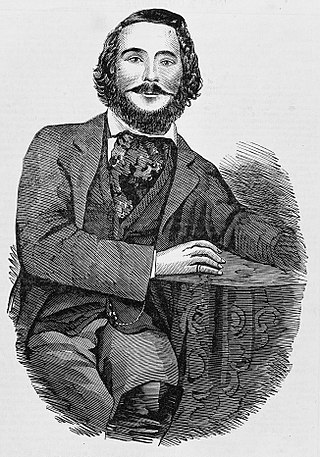
Frank Gardiner was an Australian bushranger who gained infamy for his lead role in the a robbery of a gold escort at Eugowra, New South Wales in June 1862. It is considered the largest gold heist in Australian history. Gardiner and his gang, which included bushrangers Ben Hall, John O'Meally, Johnny Gilbert, Henry Manns, Alexander Fordyce, John Bow and Dan Charters, made off with a pile of cash and 77 kilograms of gold, worth about $10 million today. After several years in prison for the robbery, Gardiner was exiled and moved to the United States, where he died in or about 1882.
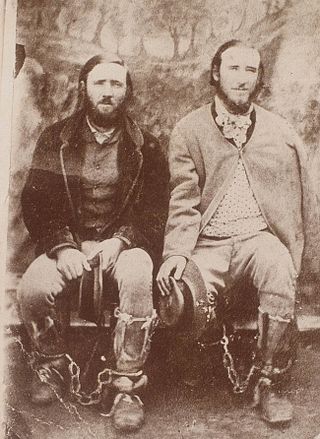
Brothers Thomas and John Clarke were Australian bushrangers from the Braidwood district of New South Wales. They committed a series of high-profile crimes which led to the enacting of the Felons' Apprehension Act (1866), a law that introduced the concept of outlawry in the colony and authorised citizens to kill bushrangers on sight. Thomas was proclaimed an outlaw on 31 May 1866.
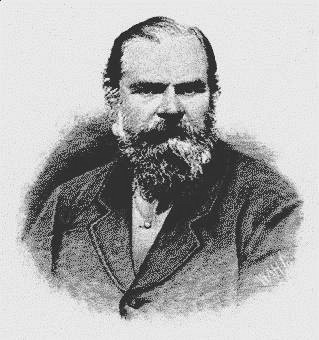
Frederick Walker was a British public servant of the Colony of New South Wales, property manager, Commandant of the Native Police, squatter and explorer, today best known as the first Commandant of the Native Police Force that operated in the colonies of New South Wales and Queensland. He was appointed commandant of this force by the NSW government in 1848 and was dismissed in 1854. During this time period the Native Police were active from the Murrumbidgee/Murray River areas through the Darling River districts and into what is now the far North Coast of NSW and southern and central Queensland. Despite this large area, most operations under Walker's command occurred on the northern side of the Macintyre River. Detachments of up to 12 troopers worked on the Clarence and Macleay Rivers in NSW until the early 1860s and patrols still extended as far south as Bourke until at least 1868. After his dismissal from the Native Police, Walker became involved in the pastoral industry as a squatter, as well as organising a private native police force and leading a number of expeditions into Northern Queensland.

Australian native police were specialised mounted military units consisting of detachments of Aboriginal troopers under the command of white officers appointed by colonial governments. These units existed in various forms in colonial Australia during the nineteenth and, in some cases, into the twentieth centuries. From temporary base camps and barracks, Native Police were primarily used to patrol the often vast geographical areas along the colonial frontier in order to conduct indiscriminate raids and punitive expeditions against Aboriginal people. The Native Police proved to be a brutally destructive instrument in the disintegration and dispossession of Indigenous Australians. Armed with rifles, carbines and swords, they were also deployed to escort surveying groups, gold convoys and groups of pastoralists and prospectors.
The following lists events that happened during 1865 in Australia.
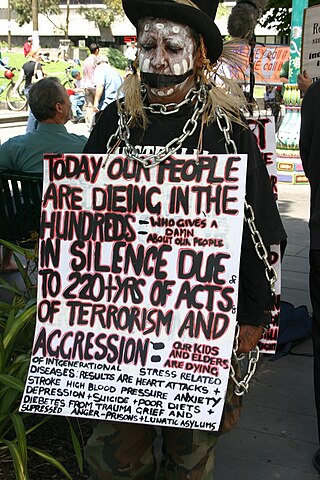
Dja Dja Wurrung, also known as the Djaara or Jajowrong people and Loddon River tribe, are an Aboriginal Australian people who claim they were the traditional owners of lands including the watersheds of the Loddon and Avoca rivers in the Bendigo region of central Victoria, Australia. They are part of the Kulin alliance of Aboriginal Victorian peoples. There are 16 clans, which adhere to a patrilineal system. Like other Kulin peoples, there are two moieties: Bunjil the eagle and Waa the crow.
The Blood Hole massacre occurred in what is now the Australian state of Victoria at Middle Creek, 10–11 kilometres (6–7 mi) from Glengower Station between Clunes and Newstead at the end of 1839 or early 1840, killing an unknown number of Aboriginals from the Grampians district who were on their way home after trading goods for green stone axe blanks that they obtained near what is now Lancefield.
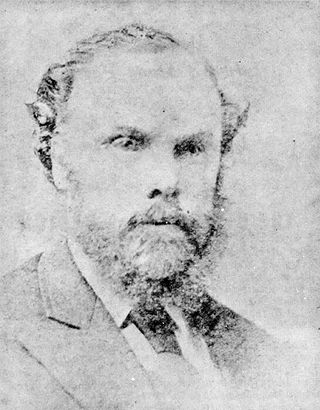
Edward Stone Parker (1802–1865) was a Methodist preacher and assistant Protector of Aborigines in the Aboriginal Protectorate established in the Port Phillip District of colonial New South Wales under George Augustus Robinson in 1838. He established and administered the Franklinford Aboriginal Protectorate Station in the territory of the Dja Dja Wurrung people from January 1841 to the end of 1848.

Franklinford is a locality in the Central Highlands of Victoria, Australia, located in the Shire of Hepburn.

Mount Franklin is an extinct volcano about 10 km north of Daylesford and 4.6 km south east of Franklinford in Victoria, Australia. A road spirals round the outside slopes covered with pine trees, into a flat 50 acre caldera, now used as a camping ground, and onto the rim which hosts a fire lookout, parking area and picnic ground.

The New South Wales Mounted Police Unit is a mounted section of the New South Wales Police Force. Founded by Governor Sir Thomas Brisbane, on 7 September 1825, the Mounted Police were recruited from a British military regiment stationed in NSW at the time, to protect travellers, suppress convict escapees and fight Indigenous Australians. The force remained the mounted division of the British Army in the colony of New South Wales until 1850, when it took upon a more civilian role. The NSW Mounted Police Unit is the oldest continuous mounted group in the world.
An Aboriginal reserve, also called simply reserve, was a government-sanctioned settlement for Aboriginal Australians, created under various state and federal legislation. Along with missions and other institutions, they were used from the 19th century to the 1960s to keep Aboriginal people separate from the white Australian population, for various reasons perceived by the government of the day. The Aboriginal reserve laws gave governments much power over all aspects of Aboriginal people’s lives.
The Border Police of New South Wales was a frontier policing body introduced by the colonial government of New South Wales with the passing of the Crown Lands Unauthorised Occupation Act 1839.

John Murray was a Scottish officer in the Australian native police in the British colonies of New South Wales and Queensland. He was an integral part of this paramilitary force for nearly twenty years, supporting European colonisation in south-eastern, central and northern Queensland. He also had an important role in recruiting troopers for the Native Police from the Riverina District in New South Wales.
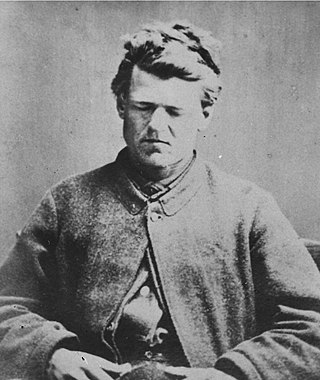
Bluecap was an Australian bushranger. Born and raised in New South Wales, he began bushranging in 1867, leading a gang responsible for robberies throughout the Riverina region. He suffered from ophthalmia, and earned his alias on account of a piece of cloth he wore to protect his eyes from sunlight. Captured in November 1867, Bluecap was tried and convicted of armed robbery. He was imprisoned in Parramatta Gaol and released in 1874.
The Eumeralla Wars were the violent encounters over the possession of land between British colonists and Gunditjmara Aboriginal people in what is now called the Western District area of south west Victoria.
Strangways is a locality within the local government area of Mount Alexander, in Central Victoria, Australia. It covers an area of 20.105 square kilometres between the townships of Guidford to the east, Newstead to the north-west and Clydesdale to the south.















